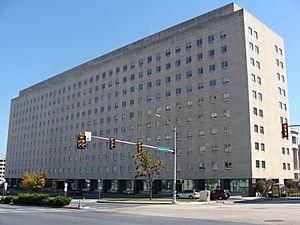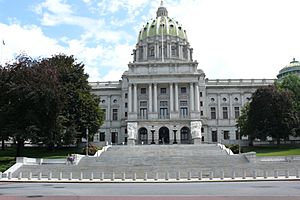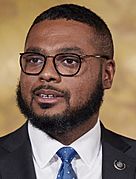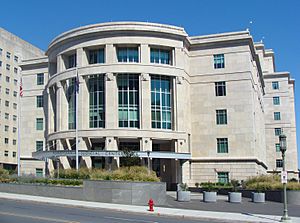Government of Pennsylvania facts for kids

|
|
| Polity type | Presidential System |
|---|---|
| Constitution | Constitution of Pennsylvania |
| Legislative branch | |
| Name | General Assembly |
| Type | Bicameral |
| Meeting place | Pennsylvania State Capitol |
| Upper house | |
| Name | Senate |
| Presiding officer | Austin Davis, President |
| Lower house | |
| Name | House of Representatives |
| Presiding officer | Joanna McClinton, Speaker |
| Executive branch | |
| Head of State and Government | |
| Title | Governor |
| Currently | Josh Shapiro |
| Appointer | Election |
| Cabinet | |
| Name | Cabinet |
| Leader | Governor |
| Deputy leader | Lieutenant Governor |
| Headquarters | State Capitol |
| Judicial branch | |
| Name | Judiciary of Pennsylvania |
| Courts | Courts of Pennsylvania |
| Supreme Court of Pennsylvania | |
| Chief judge | Debra Todd |
| Seat | Pittsburgh, Philadelphia, Harrisburg |
The Government of the Commonwealth of Pennsylvania is how the state of Pennsylvania is run. It's set up by the Pennsylvania Constitution, which is like the state's rulebook. This government has three main parts, called branches: the executive, legislative, and judicial. Each branch has different jobs to make sure the state works well. The capital city of Pennsylvania is Harrisburg.
Contents
Pennsylvania's Executive Branch
The executive branch is in charge of carrying out the laws. The main leader of this branch is the Governor. Other important elected officials help the Governor.
-
Josh Shapiro (D)
Governor -
Timothy DeFoor (R)
Auditor General -
Stacy Garrity (R)
State Treasurer
People who work in the executive branch are elected for four-year terms. They can serve a maximum of two terms. Not all executive branch elections happen at the same time. The Governor and Lieutenant Governor are elected in years when there isn't a presidential election. Other statewide officials are elected during presidential election years.
What Does the Governor's Cabinet Do?
The Governor has a team of leaders called the Cabinet. These leaders are in charge of different state agencies, which are like departments that handle specific tasks. They help the Governor manage the state and make sure services are provided to the people of Pennsylvania.

Some of the important departments in the Governor's Cabinet include:
- Department of Community and Economic Development (DCED)
- Department of Aging
- Department of Corrections (DOC)
- Department of Transportation (PennDOT)
- Department of Health
- Department of Environmental Protection (DEP)
- Pennsylvania State Police (PSP)
- Department of Human Services (DHS)
- Department of Labor & Industry (L&I)
- Department of Agriculture
- Department of Education (PDE)
The Pennsylvania Bulletin is a weekly publication that shares new rules and important announcements from the government. These rules are then organized into the Pennsylvania Code.
Pennsylvania's Legislative Branch
The legislative branch is responsible for making laws. In Pennsylvania, this branch is called the Pennsylvania General Assembly. It has two parts: the Pennsylvania House of Representatives and the Pennsylvania State Senate. Having two parts is called being "bicameral."

The House of Representatives has 203 members, and the Senate has 50 members. The leader of the House is called the Speaker. The Lieutenant Governor is the President of the Senate, but they only vote if there's a tie. Both parts of the General Assembly meet at the Pennsylvania State Capitol in Harrisburg.
The laws they create are published in the Laws of Pennsylvania. These laws are then organized into the Pennsylvania Consolidated Statutes. Members of the General Assembly cannot hold other civic jobs. If a member is found guilty of corruption, they can be removed and can never run for election again.
Pennsylvania's Judicial Branch
The judicial branch is in charge of interpreting the laws and making sure they are applied fairly. This branch includes all the courts and judges in Pennsylvania.
Pennsylvania is divided into 60 judicial districts. Most districts have "magisterial district judges." These judges handle smaller cases, like minor crimes and small civil disputes. They also hold early hearings for more serious criminal cases.
Most criminal and civil cases start in the Courts of Common Pleas. These courts also review decisions made by the district judges. The Superior Court handles appeals from the Courts of Common Pleas for many types of cases. The Commonwealth Court mainly handles appeals related to state agencies and some specific cases from the Courts of Common Pleas.
The highest court in Pennsylvania is the Supreme Court of Pennsylvania. It is the final court for appeals. All judges in Pennsylvania are elected by the people. The chief justice, who leads the Supreme Court, is chosen based on how long they have served.
There are many judges across Pennsylvania: 439 judges in the Courts of Common Pleas, 9 in the Commonwealth Court, 15 in the Superior Court, and 7 justices in the Supreme Court. Elected judges serve 10-year terms. After that, they can run in a special election to continue serving if they wish.
Local Government in Pennsylvania
Local government is how cities, towns, and counties manage their own areas. In Pennsylvania, there are five types of local governments: counties, townships, boroughs, cities, and school districts.
Pennsylvania has 67 counties, and every part of the state belongs to one. Each county is then divided into one of the state's 2,562 municipalities. There are no areas in Pennsylvania that are not part of a municipality.
Local governments can be run in different ways. Some follow laws made by the Pennsylvania General Assembly. Others use a "home rule charter," which means they have their own special rules approved by the state. Local governments can also create and enforce their own local laws, called ordinances.
In 1935, Pennsylvania created the Local Government Commission. This group helps members of the General Assembly research issues that affect local communities. It's one of the oldest commissions of its kind in the country.
Law Enforcement in Pennsylvania
In Pennsylvania, the Pennsylvania State Police (PSP) helps keep the peace. Unlike some other states, Pennsylvania counties don't use sheriff's offices for regular patrols in areas without local police.
Some towns and cities have their own police departments. This can help them get faster responses and have police focus on their specific area. Other towns might have part-time police or rely completely on the Pennsylvania State Police. There is no extra cost for towns that choose to rely only on the PSP.
As of 2016, about half of Pennsylvania's municipalities (1,287 of them) used the PSP as their only local law enforcement. These towns make up about 17% of the state's population. About 80% of people in Pennsylvania live in areas with full-time or part-time local police. By 2019, about 66% of municipalities either used PSP only or had part-time police along with PSP. If a town uses PSP, it can collect about half of the money from traffic tickets issued in its area.
See also
- Elections in Pennsylvania
- Law of Pennsylvania
- Politics of Pennsylvania







